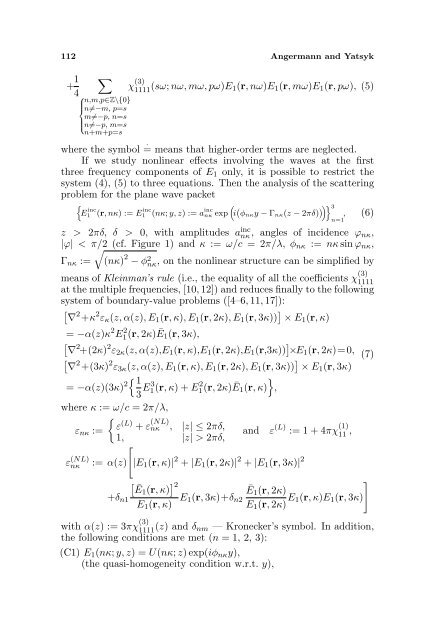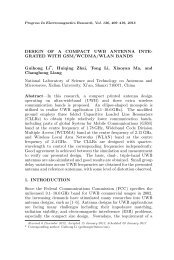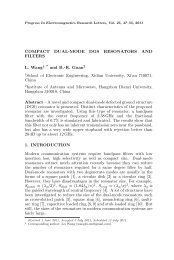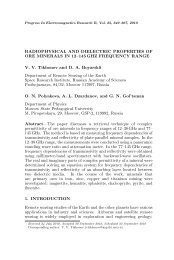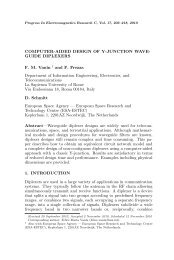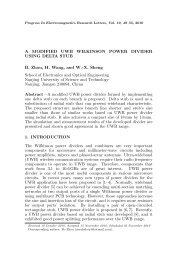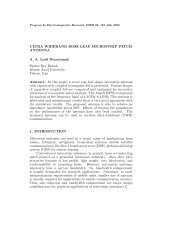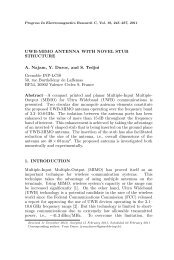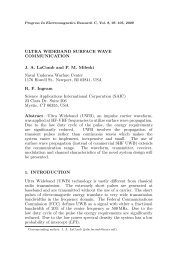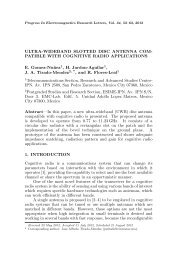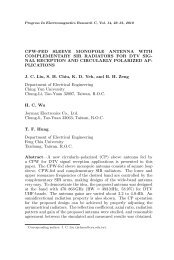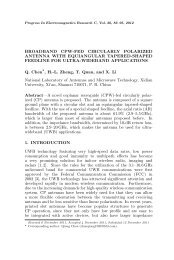PDF File (979 KB) - PIER
PDF File (979 KB) - PIER
PDF File (979 KB) - PIER
You also want an ePaper? Increase the reach of your titles
YUMPU automatically turns print PDFs into web optimized ePapers that Google loves.
112 Angermann and Yatsyk<br />
+ 1 4<br />
∑<br />
χ (3)<br />
⎧<br />
n,m,p∈Z\{0}<br />
⎪⎨ n≠−m, p=s<br />
m≠−p, n=s<br />
⎪⎩ n≠−p, m=s<br />
n+m+p=s<br />
1111 (sω; nω, mω, pω)E 1(r, nω)E 1 (r, mω)E 1 (r, pω), (5)<br />
·<br />
where the symbol = means that higher-order terms are neglected.<br />
If we study nonlinear effects involving the waves at the first<br />
three frequency components of E 1 only, it is possible to restrict the<br />
system (4), (5) to three equations. Then the analysis of the scattering<br />
problem for the plane wave packet<br />
{<br />
E1 inc (r, nκ) := E1 inc (nκ; y, z) := a inc<br />
nκ exp<br />
(i ( φ nκ y − Γ nκ (z − 2πδ) ))} 3<br />
, (6)<br />
z > 2πδ, δ > 0, with amplitudes a inc<br />
nκ, angles of incidence ϕ nκ ,<br />
|ϕ| < π/2<br />
√<br />
(cf. Figure 1) and κ := ω/c = 2π/λ, φ nκ := nκ sin ϕ nκ ,<br />
Γ nκ := (nκ) 2 − φ 2 nκ, on the nonlinear structure can be simplified by<br />
means of Kleinman’s rule (i.e., the equality of all the coefficients χ (3)<br />
1111<br />
at the multiple frequencies, [10, 12]) and reduces finally to the following<br />
system of boundary-value problems ([4–6, 11, 17]):<br />
[<br />
∇ 2 +κ 2 ε κ (z, α(z), E 1 (r, κ), E 1 (r, 2κ), E 1 (r, 3κ)) ] × E 1 (r, κ)<br />
= −α(z)κ 2 E 2 1(r, 2κ)Ē1(r, 3κ),<br />
[<br />
∇ 2 +(2κ) 2 ε 2κ (z, α(z),E 1 (r, κ),E 1 (r, 2κ),E 1 (r,3κ)) ] ×E 1 (r, 2κ)=0,<br />
[<br />
∇ 2 +(3κ) 2 ε 3κ (z, α(z), E 1 (r, κ), E 1 (r, 2κ), E 1 (r, 3κ)) ] × E 1 (r, 3κ)<br />
= −α(z)(3κ) 2{ 1<br />
}<br />
3 E3 1(r, κ) + E1(r, 2 2κ)Ē1(r, κ) ,<br />
where κ := ω/c = 2π/λ,<br />
{<br />
ε nκ := ε (L) + ε (NL)<br />
nκ , |z| ≤ 2πδ,<br />
and ε (L) := 1 + 4πχ (1)<br />
11<br />
1, |z| > 2πδ,<br />
,<br />
[<br />
ε (NL)<br />
nκ<br />
:= α(z)<br />
|E 1 (r, κ)| 2 + |E 1 (r, 2κ)| 2 + |E 1 (r, 3κ)| 2<br />
[Ē1 (r, κ) ] ]<br />
2<br />
+δ n1<br />
E 1 (r, κ) E Ē 1 (r, 2κ)<br />
1(r, 3κ)+δ n2<br />
E 1 (r, 2κ) E 1(r, κ)E 1 (r, 3κ)<br />
with α(z) := 3πχ (3)<br />
1111 (z) and δ nm — Kronecker’s symbol. In addition,<br />
the following conditions are met (n = 1, 2, 3):<br />
(C1) E 1 (nκ; y, z) = U(nκ; z) exp(iφ nκ y),<br />
(the quasi-homogeneity condition w.r.t. y),<br />
n=1<br />
(7)


